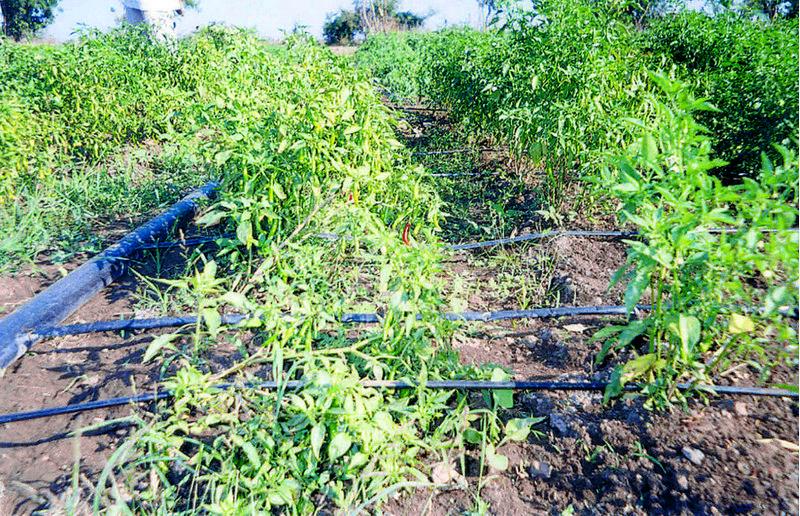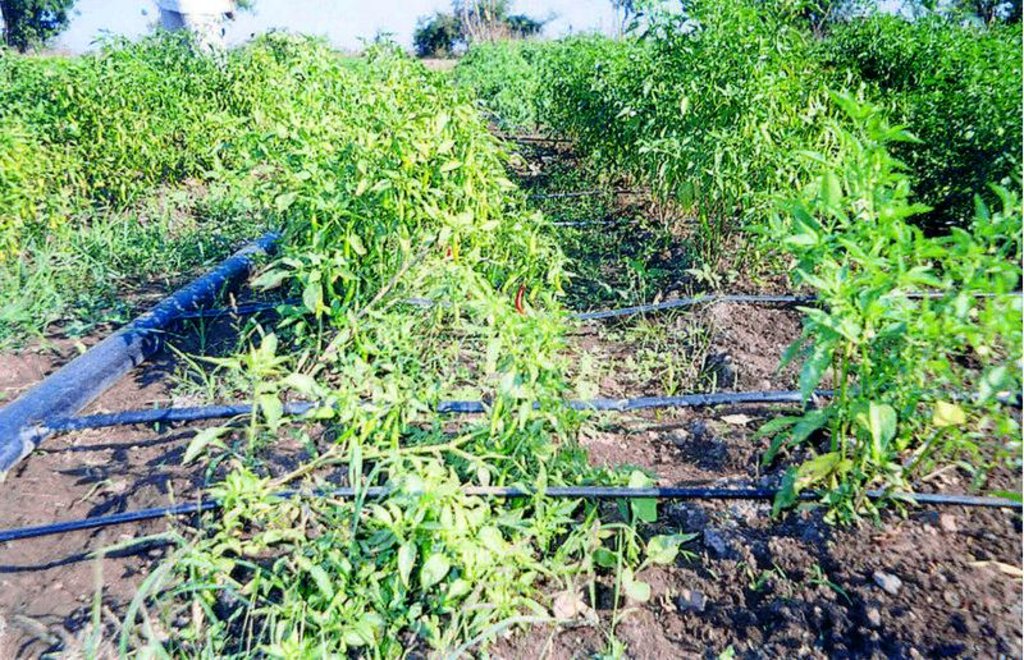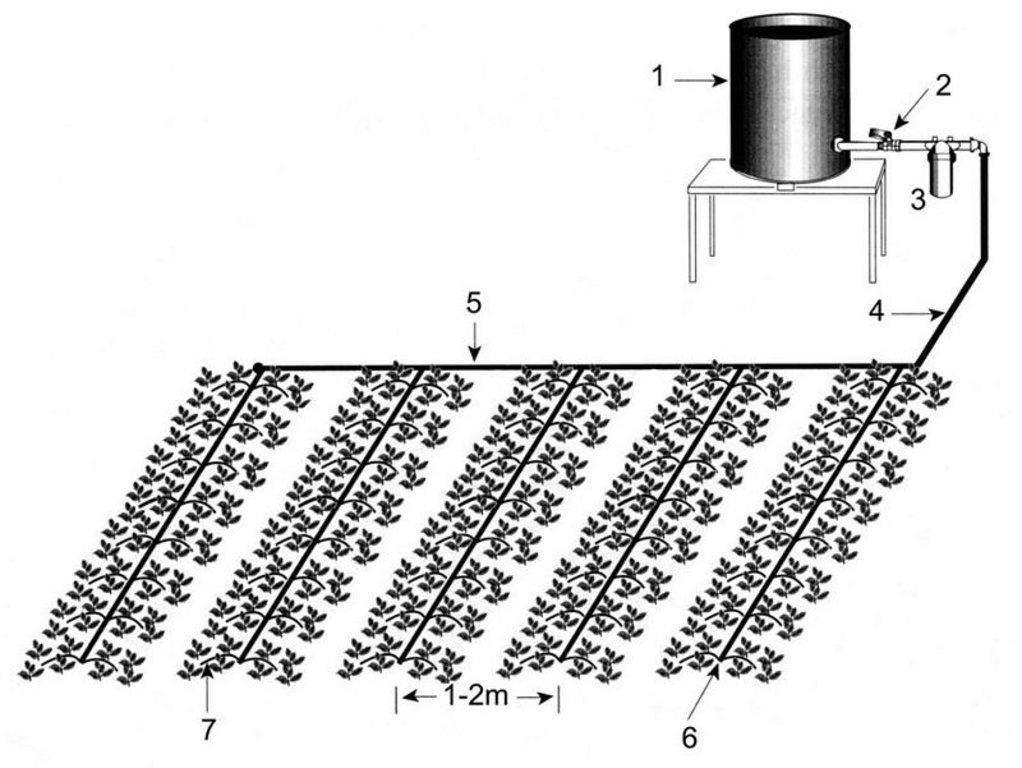Pepsee micro-irrigation system [Индия]
- Создание:
- Обновить:
- Составитель: Shilp Verma
- Редактор: –
- Рецензенты: Fabian Ottiger, Alexandra Gavilano
Pepsee
technologies_1477 - Индия
Просмотреть разделы
Развернуть все Свернуть все1. Общая информация
1.2 Контактные данные специалистов и организаций, участвующих в описании и оценке Технологии
Специалист по УЗП:
Sadagani Amitabha
International Development Enterprises
Индия
Название проекта, содействовавшего документированию/оценке Технологии (если применимо)
Book project: where the land is greener - Case Studies and Analysis of Soil and Water Conservation Initiatives Worldwide (where the land is greener)Название организации (-ий), содействовавших документированию/оценке Технологии (если применимо)
International Water Management Institute (International Water Management Institute) - ИндияНазвание организации (-ий), содействовавших документированию/оценке Технологии (если применимо)
International Development Enterprises - India (iDE-India) - Соединенные Штаты Америки1.3 Условия, регламентирующие использование данных, собранных ВОКАТ
Составитель и ответственный(-ые) специалист(-ы) согласны с условиями, регламентирующими использование собранных ВОКАТ данных:
Да
1.5 Ссылка на Анкету (ы) по Подходам УЗП (документируется с использованием ВОКАТ)

Market support and branding for input quality (Krishak … [Индия]
Market development and support through use of a brand name - Krishak Bandhu ('the farmer's friend') - to help ensure quality amongst manufacturers and suppliers of drip irrigation equipment.
- Составитель: Shilp Verma
2. Описание Технологии УЗП
2.1 Краткое описание Технологии
Определение Технологии:
A grassroots innovation that offers most of the advantages of conventional micro-irrigation at a much lower establishment cost.
2.2 Подробное описание Технологии
Описание:
The continued expansion of irrigation in India is causing increasing water shortages. This may be compounded by the potential effects of climate change. Drip irrigation - delivering small amounts of water directly to the plants through pipes - is a technology that could help farmers deal with water constraints. It is considerably more efficient in terms of water use than the usual open furrows or flood irrigation.
In West Nimar, Madhya Pradesh, droughts, diminishing groundwater, limited and erratic power supply coupled with poverty, compelled farmers to look for a technology that would enable them to irrigate their crops (mainly cotton) within these constraints. They tried out several cost-saving options such as using old bicycle tubes instead of the conventional drip irrigation pipes. But nothing caught on - until about five years ago - when a local farmer experimented with thin poly-tubing normally used for frozen fruit-flavoured ‘lollypops’ called pepsee. It spread to neighbouring cotton farmers, and its popularity has meant that today pepsee has become widespread in the region. Pepsee micro-irrigation systems slowly and regularly apply water directly to the root zone of plants through a network of economically designed plastic pipes and low-discharge emitters.
Technically speaking pepsee systems use low density polythene (65-130 microns) tubes which are locally assembled. Being a low pressure system the water source can be an overhead tank or a manually operated water pump to lift water from a shallow water table.
Such a system costs less than US$ 40 per hectare for establishment. But the tubes have a short life span of one (or two) year(s); an equivalent standard buried strip drip irrigation system amounts to between five and ten times the initial cost. The latter would, however, last for five to ten years. The critical factor is the low entry cost. Pepsee systems thus act as ‘stepping stones’ for poor farmers who are facing water stress but are short of capital and cannot afford to risk relatively large investment in a technology which is new to them, and whose returns are uncertain. The technology is today available in two variants: the original white pepsee and a recently introduced black pepsee which is of slightly better quality.
Recently, a more durable and standardised version of pepsee, given the brand name ‘Easy Drip’, has been developed and promoted by a local NGO, IDEI (see corresponding approach). Easy Drip is one product within a set of affordable micro-irrigation technologies (AMIT) promoted by IDEI.
2.3 Фотографии, иллюстрирующие Технологию
2.5 Страна/ регион/ места, где применяется Технология, информация о которых собрана в данной Анкете
Страна:
Индия
Административная единица (Район/Область):
Madhya Pradesh
Более точная привязка места:
West Nimar
Map
×2.7 Внедрение Технологии
Укажите, как именно Технология УЗП была внедрена:
- через проекты/ внешнее вмешательство
3. Классификация Технологии УЗП
3.1 Основные цели и задачи реализации Технологии
- повышение производства
- создание благоприятных экономических условий
3.2 Текущий(-ие) тип(-ы) землепользования на территории, где применяется Технология

Пахотные угодья и плантации
- Однолетние культуры
Ежегодный урожай - Уточните культуры:
- волокнистые культуры - хлопок
Число урожаев за год:
- 2
Поясните:
Longest growing period in days: 150 Longest growing period from month to month: May - Oct Second longest growing period in days: 120 Second longest growing period from month to month: Nov - Mar
Пояснения:
Major land use problems (compiler’s opinion): Acute groundwater stress associated with lowering of the groundwater table limits water for irrigation, coupled with poverty and reluctance to risk investing in relatively expensive- but efficient - drip irrigation systems.
3.4 Водоснабжение
Обеспеченность водой участков, где реализуется Технология :
- полное орошение
3.5 Категория УЗП, к которой относится Технология
- Управление орошением (включая водоснабжение и дренаж)
3.6 Мероприятия УЗП, выполняемые в рамках Технологии

инженерные мероприятия

управленческие мероприятия
Пояснения:
Main measures: structural measures, management measures
3.7 Основные проблемы деградации земель, на решение которых направлена Технология

деградация водных ресурсов
- Взг: снижение качества грунтовых вод
Пояснения:
Main type of degradation addressed: Hq: decline of groundwater quality
Main causes of degradation: deforestation / removal of natural vegetation (incl. forest fires), other human induced causes (specify) (agricultural causes), education, access to knowledge and support services (lack of knowledge)
Secondary causes of degradation: over-exploitation of vegetation for domestic use, overgrazing, droughts, land tenure (land subdivision), Land alienation
3.8 Предотвращение и снижение деградации земель, или восстановление нарушенных земель
Укажите цель Технологии по отношению к деградации земель :
- снижение деградации земель
4. Технические характеристики, мероприятия по практической реализации, вложения и стоимость
4.1 Технический рисунок, иллюстрирующий Технологию
Спецификация (пояснения к техническому рисунку):
Components of pepsee/‘Easy Drip’ irrigation systems are described below.
1) Water source: For pepsee, commonly a water pump (in most cases electric) is used to lift water from a well and directly feed the irrigation system.
Alternatively, an overhead tank (minimum of 1 m above ground level) can be used for smaller systems up to 400 m2 area.
2) Control valve: valve made of plastic or metal to regulate pressure and flow of water into the system
3) Filter: Strainer filter to ensure that clean water enters into the system (optional in pepsee systems).
4) Mainline: 50 mm PVC (Polyvinyl chloride) or PE (Polyethylene) pipe to convey water from source to the sub-main.
5) Sub-main: PVC/PE pipe to supply water to the lateral pipes which are connected to the sub-main at regular intervals.
6) Lateral: PE pipes along the rows of the crops on which emitters are connected directly. Pipe size is 12–16 mm.
7) Emitters/micro-tubes: Device through which water is emitted at the root zone of the plant with required discharge. In pepsee farmers simply make pin holes in the plastic tube for water to pass. Easy Drip has inbuilt drippers/outlets along the lateral line which give a continuous wetting strip.
It is mainly used for row crops.
Pepsee uses cheap, recycled plastic tubes instead of the rubber pipes used in conventional drip irrigation kits. Space between emitters is variable, for cotton cultivation it is commonly 1.2 m (between plants, within and between rows). There is (usually) one emitter for each plant. Different sizes of valves, mainlines, etc, are available, depending on flow rate of water in the system. Additional components are joints (connectors) and pegs (used to hold the lateral and micro-pipes in place).
Technical knowledge required for land users: moderate
Main technical functions: water supply, improved water-use efficiency (reduced loss, well directed, selective - and targeted irrigation
Secondary technical functions: improvement of ground cover, higher - germination and establishment rate
Structural measure: irrigation infrastructure
Construction material (other): poly-tubes - low density polythene (65-130 microns)
Change of land use practices / intensity level: from furrow to drip irrigation
Автор:
Sijali IV 2001, Drip irrigation, RELMA, Nairobi
4.3 Мероприятия, необходимые для начала реализации
| Деятельность | Время (сессия) | |
|---|---|---|
| 1. | Installation of water pump, control valve, filter (optional) and PVC piping(main/sub-main and lateral pipes). | dry season |
4.4 Вложения и затраты, необходимые для начала реализации
| Опишите затраты | Единица | Количество | Затраты на единицу | Общая стоимость на единицу | % затрат, оплаченных землепользователями | |
|---|---|---|---|---|---|---|
| Оплата труда | Labour | ha | 1,0 | 4,0 | 4,0 | 100,0 |
| Строительные материалы | Lateral piping (Pepsee tube) | ha | 1,0 | 17,0 | 17,0 | 100,0 |
| Строительные материалы | Main/sub-main PVC piping | ha | 1,0 | 34,0 | 34,0 | 100,0 |
| Строительные материалы | Other parts (valves, joints et | ha | 1,0 | 40,0 | 40,0 | 100,0 |
| Общая стоимость запуска Технологии | 95,0 | |||||
| Общие затраты на создание Технологии в долларах США | 95,0 | |||||
Пояснения:
Duration of establishment phase: 1 month(s)
4.5 Поддержание/ текущее обслуживание
| Деятельность | Сроки/ повторяемость проведения | |
|---|---|---|
| 1. | Re-installation of lateral pepsee tubes | dry season/ (every 1–2 years). |
4.6 Стоимость поддержания/ текущего обслуживания ( в год)
| Опишите затраты | Единица | Количество | Затраты на единицу | Общая стоимость на единицу | % затрат, оплаченных землепользователями | |
|---|---|---|---|---|---|---|
| Оплата труда | Labour | ha | 1,0 | 4,0 | 4,0 | 100,0 |
| Строительные материалы | Lateral piping (Pepsee tube) | ha | 1,0 | 17,0 | 17,0 | 100,0 |
| Общая стоимость поддержания Технологии | 21,0 | |||||
| Общие затраты на поддержание Технологии в долларах США | 21,0 | |||||
5. Природные и социально-экономические условия
5.1 Климат
Среднегодовое количество осадков
- < 250 мм
- 251-500 мм
- 501-750 мм
- 751-1000 мм
- 1001-1500 мм
- 1501-2000 мм
- 2001-3000 мм
- 3001-4000 мм
- > 4000 мм
Агроклиматическая зона
- полузасушливая
5.2 Рельеф
Склоны (преобладающие):
- пологие (0-2%)
- покатые (3-5%)
- покато-крутые (6-10%)
- крутые (11-15%)
- очень крутые (16-30%)
- чрезвычайно крутые (31-60%)
- обрывистые (>60%)
Формы рельефа:
- плато/ равнины
- гребни хребтов/холмов
- склоны гор
- склоны холмов
- подножья
- днища долин
Зона высотной поясности:
- 0-100 м над уровнем моря
- 101-500 м н.у.м.
- 501-1000 м н.у.м.
- 1001-1500 м н.у.м.
- 1501-2000 м н.у.м.
- 2001-2500 м н.у.м.
- 2501-3000 м н.у.м.
- 3001-4000 м н.у.м.
- > 4 тыс. м н.у.м.
5.3 Почвы
Средняя мощность почв:
- поверхностные (0-20 см)
- неглубокие (21-50 см)
- умеренно глубокие (51-80 см)
- глубокие (81-120 см)
- очень глубокие (> 120 см)
Гранулометрический состав (верхнего горизонта):
- тонкодисперсный/ тяжёлый (глинистый)
Содержание органического вещества в верхнем горизонте:
- среднее (1-3%)
Если возможно, приложите полное описание почв или укажите доступную информацию, например тип почв, рH/ кислотность почв, ёмкость катионного обмена, содержание азота, содержание солей и т.д.
Soil texture: Fine/heavy (black cotton soil; mostly vertisols, partly inceptisols and entisols)
Soil drainage/infiltration: Poor
5.6 Характеристика землепользователей, применяющих Технологию
Рыночная ориентация производства:
- товарное/ рыночное хозяйство
Доходы из других источников:
- < 10% всех доходов
5.7 Средняя площадь земель, используемых землепользователями с применением Технологии
- < 0,5 га
- 0,5-1 га
- 1-2 га
- 2-5 га
- 5-15 га
- 15-50 га
- 50-100 га
- 100-500 га
- 500-1000 га
- 1000-10000 га
- > 10000 га
5.8 Собственность на землю, права на земле- и водопользование
Землевладелец:
- индивидуальная, оформленная в собственность
Право землепользования:
- индивидуальное
6. Воздействия и заключительные положения
6.1 Влияние Технологии УЗП в пределах территории ее применения
Социально-экономическое воздействие
Продуктивность
производство сельскозяйственных культур
площадь, используемая для производства продукции
Комментарий/ пояснения:
More land brought under irrigation. This is seen as a negative aspect
Доходы и затраты
объем работ
Другое социально-экономическое воздействие
irrigated area
Комментарий/ пояснения:
Greater irrigated area with same amount of water
Социальное и культурное воздействие
права на землю/воду
Комментарий/ пояснения:
More farmers able to irrigate their land
положение социально и экономически уязвимых групп населения
Комментарий/ пояснения:
Poverty reduction
Social acceptance
Комментарий/ пояснения:
Drip irrigation confers the image of a progressive farmer
Экологическое воздействие
Другие экологические последствия
Water use efficiency
6.4 Анализ эффективности затрат
Насколько получаемый результат сопоставим с первоначальными вложениями (с точки зрения землепользователей)?
Эффективность затрат в краткосрочной перспективе:
позитивное
Эффективность затрат в долгосрочной перспективе:
позитивное
Насколько получаемый результат сопоставим с текущими расходами по поддержанию технологии (с точки зрения землепользователей)?
Эффективность затрат в краткосрочной перспективе:
позитивное
Эффективность затрат в долгосрочной перспективе:
позитивное
6.5 Внедрение Технологии
Среди применяющих Технологию землепользователей, какова доля лиц, применяющих её по собственной инициативе, т.е. без какого-либо материального стимулирования со стороны?
- 91-100%
Пояснения:
100% of land user families have adopted the Technology without any external material support
There is a moderate trend towards spontaneous adoption of the Technology
Comments on adoption trend: No detailed information available regarding spread - though this is estimated to be several thousand farmers within West Nimar. All adoption has been spontaneous, without incentives, and the group which has adopted best comprises those who were previously using furrow irrigation. A large number of pepsee adopters are the resource poor farmers but rich farmers have also adopted pepsee.
6.7 Сильные стороны/ преимущества/ возможности Технологии
| Сильные стороны/ преимущества/ возможности по мнению составителя или других ключевых специалистов |
|---|
|
Low initial investment and recurrent costs: risk in adopting new system limited How can they be sustained / enhanced? Keep costs of new variations of pepsee low. |
|
There are significant benefits in terms of reduced water use per unit of land, and in terms of yield per unit land area as well. |
| Few extra skills required to implement and operate the system. |
|
An eventual shift to conventional drip system is feasible: pepsee acts as a ’stepping stone’ How can they be sustained / enhanced? Promote improved drip systems where pepsee has taken off. |
|
Higher yields, better quality, higher germination rate, lower incidence of pest attack; facilitates pre-monsoon sowing. |
6.8 Слабые стороны/ недостатки/ риски Технологии и пути их преодоления
| Слабые стороны/ недостатки/ риски по мнению составителя или ответственных специалистов | Возможные пути их преодоления/снижения? |
|---|---|
|
Pepsee is based on drip pipes which have a limited life: delicate and cannot withstand high pressure |
Develop/use stronger piping materials such as ‘Easy Drip’. |
|
The increased water use efficiency has allowed an expansion in the area irrigated – which has used up the water ‘saved’. |
Develop/use stronger piping materials such as ‘Easy Drip’. |
|
Pepsee systems require replacement of lateral pipes each year and thus incur recurrent input and labour costs |
7. Справочные материалы и ссылки
7.1 Методы сбора/ источники информации
7.2 Ссылки на опубликованные материалы
Название, автор, год публикации, ISBN:
Verma S, Tsephal S. and Jose T: Pepsee Systems: grassroots innovation under groundwater stress. Water Policy, 6,pp. 303–318.. 2004.
Название, автор, год публикации, ISBN:
http://www.iwaponline.com/wp/00604/wp006040303.htm
Ссылки и модули
Развернуть все Свернуть всеСсылки

Market support and branding for input quality (Krishak … [Индия]
Market development and support through use of a brand name - Krishak Bandhu ('the farmer's friend') - to help ensure quality amongst manufacturers and suppliers of drip irrigation equipment.
- Составитель: Shilp Verma
Модули
Нет модулей





